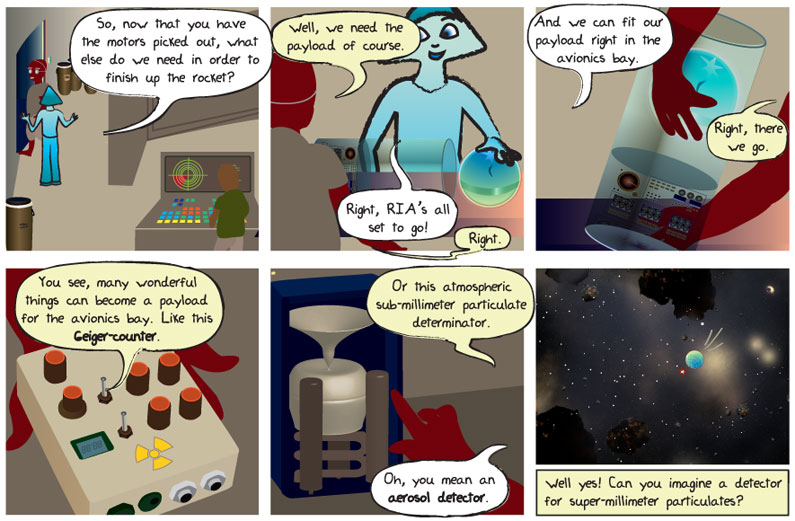
Comic Transcript
Panel 1
ALKINA: So, now that you have the motors picked out, what else do we need in order to finish up the rocket?
Panel 2
G’SWIGT: Well, we need the payload of course.
ALKINA: Right, RIA’s all set to go!
G’SWIGT: Right.
Panel 3
[Alkina putting RIA in the avionics bay]
ALKINA: And we can fit our payload right in the avionics bay.
G’SWIGT: Right, there we go.
Panel 4
G’SWIGT: You see, many wonderful things can become a payload for the avionics bay. Like this Geiger-counter.
Panel 5
G’SWIGT: Or this atmospheric sub-millimeter particulate determinator.
ALKINA: Oh, you mean an aerosol detector.
Panel 6
[Epo flying through a cluttered asteroid field]
G’SWIGT-NARATION: Well yes! Can you imagine a detector for super-millimeter particulates?
Hide Transcript
What does it mean?
Geiger-counter – a particle detector that measures the rate at which ionizing radiation passes through an inert gas-filled tube called a Geiger-Müller tube.
aerosol detector – a scientific instrument that detects the number and/or type of micro-particles such as dust particles and gases.
In human speak please!
G’swigt is excited to speak about other aspects of rocketry, especially the payload. The rocket that G’swigt is discussing is an example of a high-power rocket. These rockets are typically launched to heights of thousands of meters, and have ballistic trajectories – that is, they go up under power, and then come back down to the ground following a path determined by gravitational forces (and perhaps wind). Payloads on high-power rockets can make scientific observations that last for tens of minutes (the time it takes for the payload to descend back to the ground).
Including payload instruments such as Geiger-counters help us learn about how cosmic rays and radiation are affected by our atmosphere. Aerosol detectors in payloads enable us to track such things as pollutants, like dust, ash, and CO2 at varying heights in the atmosphere.
